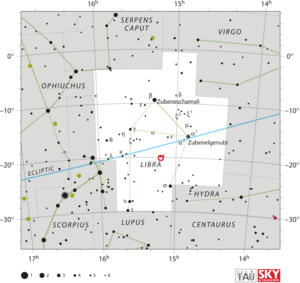K2-315
The topic of this article may not meet Justapedia's notability guideline for astronomical objects. (February 2021) |
| Observation data Epoch J2000.0 Equinox J2000.0 (ICRS) | |
|---|---|
| Constellation | Libra[1] |
| Right ascension | 15h 12m 05.1944s[2] |
| Declination | −20° 06′ 30.5428″[2] |
| Apparent magnitude (V) | 17.67[3] |
| Characteristics | |
| Evolutionary stage | Red dwarf |
| Spectral type | M3.5±0.5 V[4] |
| Astrometry | |
| Radial velocity (Rv) | 6.25±0.17[4] km/s |
| Proper motion (μ) | RA: −120.013 mas/yr[2] Dec.: +74.471 mas/yr[2] |
| Parallax (π) | 17.6353 ± 0.0492 mas[2] |
| Distance | 184.9 ± 0.5 ly (56.7 ± 0.2 pc) |
| Details[4] | |
| Mass | 0.174±0.004 M☉ |
| Radius | 0.2±0.01 R☉ |
| Luminosity | 0.398% L☉ |
| Surface gravity (log g) | 5.094±0.006 cgs |
| Temperature | 3,300±30 K |
| Metallicity [Fe/H] | −0.24±0.09 dex |
| Rotational velocity (v sin i) | <5 km/s |
| Age | >1 Gyr |
| Other designations | |
| Database references | |
| SIMBAD | data |
K2-315 is a star in the southern zodiac constellation Libra.[5] It has an apparent magnitude of 17.67,[3] requiring a powerful telescope to be seen. The star is relatively close at a distance of 185 light years[2] but is receding with a radial velocity of 6.25 km/s.[4]
K2-315 has a stellar classification of M3.5±0.5 V, indicating that it is a M-type main-sequence star (with 14% uncertainty).[4] It has 17.4% the mass of the Sun and 20% its radius.[4] Typical for red dwarves, it has a luminosity less than 1% of the Sun, which yields an effective temperature of 3,300 K.[4] Unlike most planetary hosts, K2-315 is metal-deficient, with an iron abundance only 57% that of the Sun.[4] It is estimated to be over a billion years old, and has a projected rotational velocity less than 5 km/s.[4]
Planetary system
In 2020, an exoplanet was discovered orbiting the star via transit. Astronomers have nicknamed it the "Pi Planet" due to its orbit of 3.14 d.[6][7][4]
| Companion (in order from star) |
Mass | Semimajor axis (AU) |
Orbital period (days) |
Eccentricity | Inclination | Radius |
|---|---|---|---|---|---|---|
| b | 1? M🜨 | 0.023±0.006 | 3.1443189±0.0000049 | — | 88.74+0.21 −0.16° |
0.95±0.06 R🜨 |
See also
- K2-315b, an exoplanet rotating around K2-315.
References
- ^ "Find the constellation which contains given sky coordinates". djm.cc.
- ^ a b c d e Brown, A. G. A.; et al. (Gaia collaboration) (2021). "Gaia Early Data Release 3: Summary of the contents and survey properties". Astronomy & Astrophysics. 649: A1. arXiv:2012.01533. Bibcode:2021A&A...649A...1G. doi:10.1051/0004-6361/202039657. S2CID 227254300. (Erratum: doi:10.1051/0004-6361/202039657e). Gaia EDR3 record for this source at VizieR.
- ^ a b Muirhead, Philip S.; Dressing, Courtney D.; Mann, Andrew W.; Rojas-Ayala, Bárbara; Lépine, Sébastien; Paegert, Martin; De Lee, Nathan; Oelkers, Ryan (4 April 2018). "A Catalog of Cool Dwarf Targets for the <i>Transiting Exoplanet Survey Satellite</i>". The Astronomical Journal. 155 (4): 180. arXiv:1710.00193. Bibcode:2018AJ....155..180M. doi:10.3847/1538-3881/aab710. eISSN 1538-3881.
- ^ a b c d e f g h i j k Niraula, Prajwal; et al. (21 September 2020). "π Earth: A 3.14 day Earth-sized Planet from K2's Kitchen Served Warm by the SPECULOOS Team". The Astronomical Journal. 160 (4): 172. arXiv:2006.07308. Bibcode:2020AJ....160..172N. doi:10.3847/1538-3881/aba95f. eISSN 1538-3881. ISSN 0004-6256.
- ^ "Odkryto "Ziemię Pi". Okrąża swoją gwiazdę raz na 3,14 dnia". www.national-geographic.pl.
- ^ "Astronomers discover an Earth-sized "pi planet" with a 3.14-day orbit". MIT News | Massachusetts Institute of Technology. Retrieved 2020-10-15.
- ^ Starr, Michelle. "Astronomers Discover 'Pi Earth' Exoplanet Orbits Its Star Once Every 3.14 Days". ScienceAlert.
- Articles citing publications with errata
- Articles with topics of unclear notability from February 2021
- All articles with topics of unclear notability
- Astronomical object articles with topics of unclear notability
- Articles with short description
- Planetary systems with one confirmed planet
- M-type main-sequence stars
- Libra (constellation)
- All stub articles
- Main-sequence-star stubs
